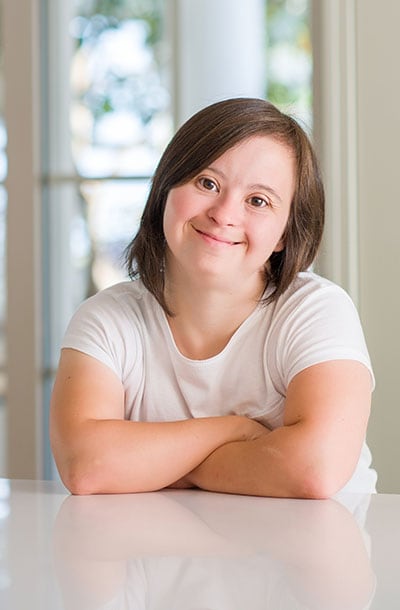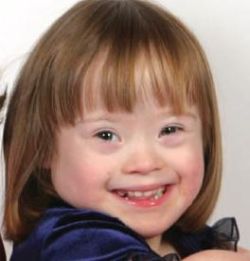
 Assessing speech-language abilities of children with genetic disorders and developmental disabilities is no easy feat. Although developmental and genetic disorders affecting cognition, communication and functioning are increasingly widespread, speech-language assessment procedures for select populations (e.g., Down Syndrome) remain poorly understood by many speech-language professionals, resulting in ineffective or inappropriate service provision. Continue reading Comprehensive Assessment of Monolingual and Bilingual Children with Down Syndrome
Assessing speech-language abilities of children with genetic disorders and developmental disabilities is no easy feat. Although developmental and genetic disorders affecting cognition, communication and functioning are increasingly widespread, speech-language assessment procedures for select populations (e.g., Down Syndrome) remain poorly understood by many speech-language professionals, resulting in ineffective or inappropriate service provision. Continue reading Comprehensive Assessment of Monolingual and Bilingual Children with Down Syndrome
Category: genetic syndromes
Spotlight on Syndromes: An SLPs Perspective on Fragile X Syndrome
 Today’s guest post on Fragile X Syndrome comes from Happily SLP, Carly Fowler.
Today’s guest post on Fragile X Syndrome comes from Happily SLP, Carly Fowler.
Fragile X is an inherited disorder that is associated with mental retardation and developmental disorder. This is a sex-linked disorder. Fragile X is linked to the 23rd chromosomal pair; specifically the X chromosome. Physical characteristics of fragile X syndrome (FXS) in males are a long face, large ears, and macroorchidism (enlarged testicles). Often individuals also have loose connective tissue, double jointed-ness and flat feet. Many young children do not show these characteristics until they reach puberty (Abbeduto & Jenssen Hagerman, 1997). Continue reading Spotlight on Syndromes: An SLPs Perspective on Fragile X Syndrome
Spotlight on Syndromes: An SLPs Perspective on Apert Syndrome
 Today’s guest post on genetic syndromes comes from Rebecca Freeh Thornburg, who is contributing information on the Apert Syndrome. Rebecca is a repeated guest blog contributor. Her informative guest post on the CHARGE Syndrome can be found HERE.
Today’s guest post on genetic syndromes comes from Rebecca Freeh Thornburg, who is contributing information on the Apert Syndrome. Rebecca is a repeated guest blog contributor. Her informative guest post on the CHARGE Syndrome can be found HERE.
Overview
Apert Syndrome is a genetic condition resulting from a mutation in gene FGRF2 – fibroblast growth factor receptor 2 – on chromosome 10. Incidence estimates vary from 1 in 65,000 to 1 in 120,000 births. Most cases of Apert syndrome result from a new mutation, rather than being genetically inherited from a parent. Children born with Apert Syndrome are affected by characteristic craniofacial differences caused by premature fusion of the bones of the skull, as well and limb anomalies, especially fusion of skin of the fingers and/or toes. Multiple craniofacial and limb procedures, as well as other surgical interventions are often necessary to minimize the medical complications and cosmetic impact of the disorder. Continue reading Spotlight on Syndromes: An SLPs Perspective on Apert Syndrome
Spotlight on Syndromes: An SPLs Perspective on Monosomy 13q Syndrome
 Today’s guest post on Monosomy 13q Syndrome is brought to you by the ever talented Maria Del Duca, M.S. CCC-SLP of Communication Station: Speech Therapy, PLLC, located in southern Arizona.
Today’s guest post on Monosomy 13q Syndrome is brought to you by the ever talented Maria Del Duca, M.S. CCC-SLP of Communication Station: Speech Therapy, PLLC, located in southern Arizona.
Overview: Also known as “13q Deletion Syndrome”, this is a chromosomal disorder that results in intellectual disabilities as well as congenital malformations of the skeleton, heart, brain and eyes. The causes of this syndrome can be hereditary or non-hereditary. When the long arm of chromosome 13 (labeled “q”) is missing/deleted or when both parts of chromosome 13 have been lost/deleted and have reconnected to form a ring (called “ring chromosome 13”), and the genetic mutation occurs before conception, during formation of the egg and sperm (gametes), this results in “monosomy 13q” (non-hereditary genetic mutation). However, there are times the cause is due to a parent carrier who passed down an inverted or translocated chromosome to the child subsequently resulting in a hereditary etiology. Risk of 13q Deletion Syndrome to occur in subsequent pregnancies is very low. If mother is the carrier, the risk is 10-15% and if the father is the carrier the risk is 2-4%. Continue reading Spotlight on Syndromes: An SPLs Perspective on Monosomy 13q Syndrome
Spotlight on Syndromes: An SLPs and OTs Perspective on Williams Syndrome
 Today’s guest post on Williams Syndrome comes from Pamela Mandell, M.S. CCC-SLP with a contribution from Priya Deonarain, MA, OTR/L, CKTP.
Today’s guest post on Williams Syndrome comes from Pamela Mandell, M.S. CCC-SLP with a contribution from Priya Deonarain, MA, OTR/L, CKTP.
Overview
Williams syndrome (WS), also known as Williams-Beuren Syndrome, is a rare genetic disorder caused by the deletion of the long arm of chromosome 7 or, more specifically a microdeletion at 7q11.23, which involves the elastin gene. WS occurs in approximately 1 in 10,000 births worldwide. It is characterized by cardiovascular disease, dysmorphic craniofacial features, a characteristic cognitive and personality profile, deficient visuospatial abilities, hyperacusis, growth retardation, developmental delays, feeding difficulties, and learning disabilities. However, many people with WS exhibit strong expressive language skills and an affinity for music. Mild to severe anxieties as well as Attention Deficit Hyperactivity Disorder (ADHD) are also associated with WS. The degree of severity or involvement of these characteristics is variable and no two individuals with WS are alike. WS affects both males and females equally. Sadler, et al. (2001), determined the severity of both supravalvular aortic stenosis (SVAS) and total cardiovascular disease was significantly higher in males than females. There is no cure for WS. Patients must be continually monitored and treated for symptoms throughout their lives. Continue reading Spotlight on Syndromes: An SLPs and OTs Perspective on Williams Syndrome
Spotlight on Syndromes: An SLPs Perspective on CHARGE Syndrome
 Today’s guest post on genetic syndromes comes from Rebecca Freeh Thornburg, who is contributing on CHARGE Syndrome.
Today’s guest post on genetic syndromes comes from Rebecca Freeh Thornburg, who is contributing on CHARGE Syndrome.
Overview:
CHARGE Syndrome is an extremely complex genetic condition encompassing anomalies of multiple systems. CHARGE affects approximately 1 in every 9 to 10,000 live births, worldwide. Respiratory issues and complex cardiac defects often require early and frequent hospitalization and surgical intervention. Characteristic hearing and vision impairments also contribute to delays in development. Early and ongoing intervention by speech-language pathologists and other members of a multi-disciplinary care team is critical in achieving best outcomes for children affected by CHARGE. Continue reading Spotlight on Syndromes: An SLPs Perspective on CHARGE Syndrome
Spotlight on Syndromes: An SLPs Perspective on Hurler Syndrome
Today’s guest post on genetic syndromes comes from Kelly Hungaski, who is contributing an informative piece on the Hurler Syndrome.
Hurler Syndrome is a rare, inherited metabolic disease in which a person can’t break down lengthy chains of sugar molecules called glycosaminoglycans. Hurler syndrome belongs to a group of diseases called mucopolysaccharidoses, or MPS. Continue reading Spotlight on Syndromes: An SLPs Perspective on Hurler Syndrome
Spotlight on Syndromes: An SLPs Perspective on Spinal Muscle Atrophy
 The following is an informational post on the disease SMA (spinal muscle atrophy) by Rose Ann Kesting M.A. CCC-SLP. After reading, please visit her blog post “My Wednesday Morning Wake Up Call,” for a personal account of her experience with a very special boy with Type 1 SMA and his amazingly dedicated family. Continue reading Spotlight on Syndromes: An SLPs Perspective on Spinal Muscle Atrophy
The following is an informational post on the disease SMA (spinal muscle atrophy) by Rose Ann Kesting M.A. CCC-SLP. After reading, please visit her blog post “My Wednesday Morning Wake Up Call,” for a personal account of her experience with a very special boy with Type 1 SMA and his amazingly dedicated family. Continue reading Spotlight on Syndromes: An SLPs Perspective on Spinal Muscle Atrophy
Spotlight on Syndromes: An SLPs Perspective on Menkes Syndrome
November is Menkes Awareness month, so today Olga Z. Porterfield will be contributing a post on the Menkes Syndrome.
Menkes Syndrome (MNK), also known as Menkes disease, copper transport disease, steely hair disease, kinky hair disease, or Menkes kinky hair syndrome, is a disorder originally described by John Hans Menkes (1928–2008), which affects copper levels in the body, leading to copper deficiency. It is an x-linked recessive disorder, and is therefore considerably more common in males with females requiring two defective alleles to develop the disease. It is caused by a defective gene named ATP7A gene that regulates the metabolism of copper in the body. Continue reading Spotlight on Syndromes: An SLPs Perspective on Menkes Syndrome
Spotlight on Syndromes: An SLPs Perspective on Down Syndrome
 Today’s guest post on genetic syndromes comes from Rachel Nortz, who is contributing a post on the Down Syndrome.
Today’s guest post on genetic syndromes comes from Rachel Nortz, who is contributing a post on the Down Syndrome.
Down Syndrome is a genetic disorder that is characterized by all or part of a third copy of the 21st chromosome. There are three different forms of Down syndrome: trisomy 21, translocation, and mosaicism. Trisomy 21 is the most common form of Down syndrome. This occurs when the 21st chromosome pair does not split properly and the egg or sperm receives a double-dose of the extra chromosome. Translocation (3-4% have this type) is the result of when the extra part of the 21st chromosome becomes attached (translocated) onto another chromosome. Mosaicism is the result of an extra 21st chromosome in only some of the cells and this is the least common type of Down syndrome. Continue reading Spotlight on Syndromes: An SLPs Perspective on Down Syndrome
